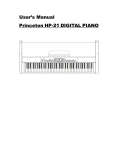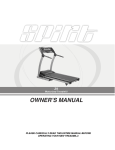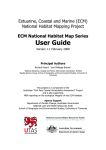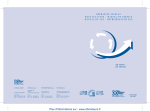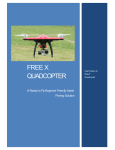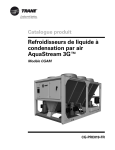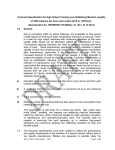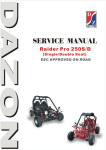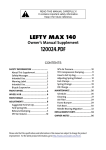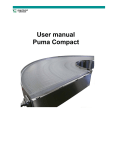Download TGR ARTICULATED DIESEL RAIL CAR
Transcript
TGR ARTICULATED DIESEL RAIL CAR – OPERATING INSTRUCTIONS DP 28 and DP 29 EX—TGR DP DIESEL RAILCARS OPERATION INSTRUCTIONS CONTENTS General Description History Technical Description Engines Transmission System Transmission Operation Auxiliary Equipment Engine & Transmission Protection Systems Drivers Cab Guards Compartment Equipment Preparation and Stabling Procedures Preparations for Starting Engines Starting the Diesel Engines Obtaining Control Changing Ends At Other End Shutting Down and Stabling Operating_Procedures Driving Reversing Auxiliary Operations Watering Lighting Heating Generator Control Box Fuel Faults General Specifications © Bellarine Peninsula Railway V1 9/09/2006 Page 1 of 9 TGR ARTICULATED DIESEL RAIL CAR – OPERATING INSTRUCTIONS DP 28 and DP 29 General These Diesel Railcars are partially air—conditioned, articulated units, which can be operated singly or in multiple unit. There is a driving cabin at each end which contains the instruments and controls necessary for the operation of the air brake equipment and the diesel engine which provides the propulsion power. History DP’s 26—29 The units were constructed between 1949 and 1951 by Commonwealth Engineering, Granville, New South Wales, using Drewry Car (UK) drive trains and power bogies and remaining running gear. The cars were constructed for the former Tasmanian Government Railways to replace steam hauled services, especially on the North West and main lines. The units saw service in all areas of the State and ended their days on the Hobart suburban system or on the Launceston—Western Junction ‘Tasman Limited’ feeder service. The units were withdrawn in 1978 when ANR abolished all passenger services in Tasmania. Of the four articulated DP’s, Road Numbers 26—29, three have been preserved. DP26 is preserved by TTMS in Hobart, whilst DP’s 28, 29 have been preserved by the B.P.R. Queenscliff, Victoria, Technical Description Engines The engines are Gardiner six cylinder, four stroke diesel engines Type 6L3B, each developing 153HP in a rev range from 350—1200 rpm Engine temperature is maintained at 110°F by cooling water, which is circulated via a water pump to the overhead radiator and then to the engine and heater unit. The lubricating oil is mechanically driven and pressure varies with engine rpm. in the range of 25—35 psi. The engine employs a pressure time fuel system. A mechanically driven fuel pump, which also contains the engine governor, draws fuel from the header tank via Amal pumps and filters and delivers it to the injectors from where it is delivered under pressure to the combustion chambers. The injectors are mechanically actuated and timed by the engine camshaft, Four AC—SPHINX oil bath cleaners are provided for each engine and are mounted on the Engine Bay cover in the driving cab. Transmission System The power from the engine is transmitted through a hydraulic coupling and cardan shaft to a gear box and reverse box to the axles. The Drewry car bogie transmission system contains the following main items Vulcan Sinclair Hydraulic coupling; Wilson-Drewry SE4 Epicyclic gear box; Drewry or David Brown reverse and final reduction gear unit; Reverse Detector switch; Pneumatic reversing rams. Transmission Operation When the Reverse Peg is put from the idle position to the forward or reverse position, this electrically selects the relevant Electro-pneumatic (EP) solenoid, which then admits air into the appropriate reversing ram thus moving it into the required position and placing the spur gear against the relevant gear inside the Reverse Box. This action selects direction. Then when the gear change peg is placed into a gear position, the following occurs. The movement of the change peg electrically operates the specific E.P solenoid for that gear, which then admits air onto the relevant change bands within the gear box. This is an epicyclic operation Also the selection of the required direction operates the Reverse Detector Switch via the striking gear on the end of the reverse box, The reverse detector circuit will then become energized and will allow the E.P for the throttle and deadman’s pneumatic circuits to operate thus indicating that all reversers on a multiple unit train have thrown In the direction of travel. The gear box provides speeds of 11mph (18kmph), 19mph (30kmph). 30mph(50kmph) and 45 mph(72 kmph) at maximum engine revolutions. © Bellarine Peninsula Railway V1 9/09/2006 Page 2 of 9 TGR ARTICULATED DIESEL RAIL CAR – OPERATING INSTRUCTIONS DP 28 and DP 29 Auxiliary Equipment Each diesel engine operates the following auxiliary equipment: 1) Westinghouse Type 4E26 Twin Air Compressor; 2) Tachometer Drive; 3) Speedometer Drive, The AIR COMPRESSOR is driven via Brammer belts from pulleys located on the front of the engine. The air compressor is located on the front right hand side of the power bogie. The TACHOMETER DRIVE is provided by the injector pump drive shaft on the left hand side of the engine and is belt driven. The SPEEDOMETER drive is located between the gear and reverse box and again is belt driven, Drivers Cab Equipment Main End Console Self lapping straight air brake; Control Air Pressure Gauge; Duplex straight & Emergency Brake Pipe Gauge; Main Reservoir Gauge; Forward & Reverse Selector Gear Selector; Warning Lights; Speedometer; Tachometer; Start/Stop Buttons; Throttle & Deadman’s facility; Light switches Horn button; Electrical Control Panel Heating switch; Lighting Control switch; Tonum florescent light control; 4 pole Master switch; (Warning Bell; Emergency light switch; Fuses; Main Buss Bars. Sundry Equipment in Cab Starter Motor isolating link; Radiator water pump; Switch Gear Box; Fuel Header tank pump; Hand Brake; Air filters; Windscreen Wiper; EP Cut out cock 3 Way Throttle cock; Sander Switch. © Bellarine Peninsula Railway V1 9/09/2006 Page 3 of 9 TGR ARTICULATED DIESEL RAIL CAR – OPERATING INSTRUCTIONS DP 28 and DP 29 Engine & Transmission Protection Systems CAB RELAY BOX (ON TOP OF ENGINE BAY) 1 REVERSE RELAY 2 OIL PRESSURE SWITCH (in box on top of engine bay) - this is a double contact relay. One pair of contacts is closed when the sensor is in a NO PRESSURE’ situation, allowing power to the starter motor and illuminating the Low Oil Pressure Lamp on the console. Once the oil pressure is greater than 22 psi., the switch energises, switching off the Low Oil Lamp and energising the E.P. valves for the deadman’s emergency valve and throttle valve, Thus, low oil pressure will cause an emergency brake application and loss of throttle control and engine speed will return to idling 3 WATER TEMPERATURE SWITCH (in box on top of engine bay) - when the engine water temperature exceeds 200 F (95C), this switch closes, causing an emergency brake application and cutting the air supply to the throttle cylinder. A blue lamp on the control desk will illuminate, (if fitted). 4. AIR PRESSURE SWITCH (in box on top of engine bay) this is to ensure that the engine throttle cannot be opened and the engine speeded up with the brakes applied and with a gear engaged, since this practise causes over-heating of the fluid coupling due to the latter running in a stalled condition. 5 DYNAMO WARNING RELAY ON THE POWER BOGIE The REVERSE DETECTOR SWITCH prevents units from moving when in M.U., unless all reversers have thrown into same director of travel, REVERSE SHORTING PLUG (6) AND SOCKET is located adjacent to the reverse detector switch and insertion of the plug electrically isolates the E.P. circuits on that car whilst a lug on the back mechanically holds the reverse tiller arm in MID (neutral) position. The plug is located in the box on top of the engine bay, and the socket is on the rear of the gear box. © Bellarine Peninsula Railway V1 9/09/2006 Page 4 of 9 TGR ARTICULATED DIESEL RAIL CAR – OPERATING INSTRUCTIONS DP 28 and DP 29 PREPARATION AND STABLING PROCEDURES 1. Preparation for Starting Engines Peruse Log Book 1.1 1.2 1.3 1.4 On Ground Check hose bags; Check MU couplings; Check Concertina Skirts; Check for any physical damage or problems; Oil brake rigging and horn cheeks, Engine Cab(s) Ensure hand brake is on; Lead cab only Close Throttle 3 way cock; Handle up Ensure direction selector is in IDLE & PEGGED; Ensure Gear selector is in NEUTRAL & PEGGED; Check Engine Oil level; Check Fuel tank; Drain fuel filters; Pump up radiator water until it overflows; Pump up fuel header tank to full level; Connect starter motor link. Check oil in Reverse Box Check oil in gear box Check split pins on reverse detector switch under reverse box tiller. Check oil in fluid coupling Remote Cab(s) Ensure Hand Brakes are off; Ensure Direction selector is in Idle and Pegged; Ensure Gear Selector is in Neutral and Pegged; Ensure 3 way cock is closed; away from you Ensure Throttle control is in idle, not Emergency or Dead mans position. Starting The Engines – Cold Start Switch ON Master Key: Oil and Generator warning lights will be illuminated. Push-up cold start and pull out Throttle linkage on fuel rack; Prime both Amal fuel Lift pumps Press Start button on console, if this fails, press Emergency Start button on starter motor. If this fails, press Start button in control box on LHS of Power Bogie. If engine still fails, follow Fault Finding Procedure Once started, engine oil pressure lamp should extinguish and oil pressure should stabilise on 30 psi. NOTE: If cars are in multiple unit, pushing of desk control start button will start all engines in train. If one fails to start after repeated attempts to start from one desk, then that engine must be checked and started locally. Starting all engines at once from cold is not a desired procedure. 1.5 Starting the engine – Low Battery If engine rotates slowly Reset the cold start button Decompress 4 cylinders by raising the decompression levers on the ctlinders Start from control desk When engine fires close decompressed cylinders. 2. Obtaining Control Once engines have started, the air reservoirs will start to fill. Engines should be left Uncontrolled at IDLE until Control Reservoir air pressure is at least 60 psi Open 3 way Throttle Control Cock © Bellarine Peninsula Railway V1 9/09/2006 Page 5 of 9 TGR ARTICULATED DIESEL RAIL CAR – OPERATING INSTRUCTIONS DP 28 and DP 29 Once 60 PSI is obtained, direction selector may be placed in desired direction of travel. Throttle Control should now be obtained, if not, check fault procedure. Control Peg may be placed into neutral position and direction selector pegged. Emergency Pipe Pressure of 75 psi should now be obtained, Main Reservoir Pressure should build up to 100 psi and unload. Insert brake handle and test brake application, Set marker lights to Lead Test headlight Check for fuel, oil, water and air leaks on engine, gearbox, fluid coupling, and final drive. Check running gear, concertina, skirts, condition of doors and windows. Secure engine bay panels. 3. Changing Ends Make sure you have a minimum Control Air pressure of 75psi. Cut out brake and Remove Brake handle Ensure Gear Selector is in NEUTRAL Ensure Direction Selector is in IDLE then select opposite direction of travel. Select Idle Close 3 way Throttle Cock; Switch Off all unnecessary lights; Leave main lighting switch ON Set marker lights to Trail Remove Master Switch key; Take brake handle, Master Switch Key and Direction Control Peg to opposite cab Close windows and lock cab doors. NOTE If turn-around time is short, there is not need to apply the hand brake, as removal of the brake handle will make an emergency application. At Other End (*Engine Cab in multiple Unit Consist) Place Handbrake ON Unlock, open windows etc.; Check engine oil pressure at least 25-35psi * Ensure Gear and Direction Selectors are in neutral positions; Insert Master switch key; two dash lights illuminate * Place Direction Selector into desired position of travel; Place Control Peg into neutral gear position; Open 3 way cock, Test Throttle; Insert Brake handle. Test brakes; Switch on required lighting. Set Marker Lights to Lead Release handbrake 4. Shutting Down and Stabling Apply hand brake; Ensure Gear Change Selector is in NEUTRAL; Move Direction Selector to IDLE position; Remove brake handle; Close Throttle 3 way cock Press Engine stop button until all engines have stopped, as indicated by Tachometers; Remove Master electrical switch; Switch all lights and heating unit off Remove starter motor link; Close windows and lock cabs; Check Radio is switched OFF; Secure Control handles; Check Fuel level and record fuel used. Fill out LOG BOOK, © Bellarine Peninsula Railway V1 9/09/2006 Page 6 of 9 TGR ARTICULATED DIESEL RAIL CAR – OPERATING INSTRUCTIONS DP 28 and DP 29 OPERATING PROCEDURE - DRIVING 1. Move Reverse Selector to forward or reverse position. 2. Release brake, Select 1st Gear and allow unit(s) to pick-up initial speed on idle revs. Once units are in motion, throttle away normally. 3. The gears provide maximum speeds of st 1 11mph (18kmph), nd 2 19mph (30kmph). rd 3 30mph (50kmph) and th 4 45 mph (72 kmph) at maximum engine revolutions 4. Never change into another gear unless the car is travelling within the speed range for that gear.(i.e. Allow revs to drop before changing up) 5. When changing down, it is important that the engine revs match the speed to which changing (i.e. increase revs first). 6. Always brake to a halt, leaving the car in the last gear used. Never reduce speed by changing down through the gears. 7. The Gear Selector must be brought smartly back to the neutral position just as the car halts. 8. Wheel slips are to be avoided at all times. Wheel slip is indicated by uneven Tachometer readings and/or a Speedo reading inconsistent with actual observed ground speed. Important Notes: Always start from rest in first gear; Never coast in neutral; Never change up or down more than one gear at a time; Never change into another gear unless the car is travelling within the range of that gear. Reversing Reversing cannot be achieved unless the Gear Selector is pegged in the neutral position. When reversing, car must be stationary. If car is permitted to move, damage may result to the Reverse Box, Car Watering: Engines Engine water tanks must be topped up daily on both units. Water filler points are those located second from the leading end Water treatment chemicals will only be added by Maintenance Staff Passenger Convenience Water: Air pressurised water is provided for the toilet, hand basin and water fountain. This tank located under the trailing unit must be topped up daily. CAUTION: This tank is pressurised and must be vented prior to removal of filler cap. Carriage Lighting The lighting on the Units falls into four categories 1. Marker/Head lighting 2. Emergency lighting 3. Incandescent lighting 4. Florescent lighting 1. Marker/Head Lighting - These lights are operated from switches on the driver’s Control panels and are controlled by the Master light switches. Each cab has a switch labelled Lead/Trail – this switch alters the aspect of the marker and tail light at that end only. Lead displays white side lights and the centre marker is extinguished. Trail displays red side marker and centre tail lights. 2. Emergency Lighting : Is switched from the switch as marked, located under the Main Control switch on the auxiliary panel at the engine end, This lighting is controlled also by the Master light switches. 3. Incandescent Lighting - Is switched, as indicated on the large ‘TONUM’ switch in the engine compartment. This switches on the normal incandescent lights throughout the car, © Bellarine Peninsula Railway V1 9/09/2006 Page 7 of 9 TGR ARTICULATED DIESEL RAIL CAR – OPERATING INSTRUCTIONS DP 28 and DP 29 4. Florescent Lights: These are also switched on as indicated by the TONUM switch and the florescent lights throughout the car are 22OvAC driven via a rotary inverter, which is located in the Guard’s compartment. Caution Notes The Rotary Inverter when driving the flouro’s draws in excess of 20 amps from the batteries, If left on for excessive periods, the car batteries will rapidly flatten. The TONUM switch has no over-riding switch and is therefore highly susceptive to unauthorised tampering, and subsequent unnecessary battery discharge. Care is to be taken in this matter, Car Heating The cars are fitted with a ducted temperature controlled heating/ventilation system. Thermostats are located throughout the unit, Operation : Switch on the Heating Master switch only. The unit will self-control its operation. The large blower motor above the air filters is driven directly from the batteries and will only cut in when 1. The temperature condition requires it; and 2. The main track-driven generator is operating. Generator Control Box Located under luggage racks near toilet, is not to be touched by anyone other than qualified maintenance staff, Fuel The fuel tank, located under the guard compartment holds approximately 60 gallons of DISTILLATE. Fuel level is obtained via dip stick in Inspection Port adjacent to Rotary Inverter. The car must not be operated if the fuel level is below 15 gallons. This is due to the following Last 8 gallons will not be picked— up by fuel pump, therefore low fuel runs the risk of running engine dry. Fuel in bottom of tank contains sediment and this is to be prevented from entering engine. Fuel filling points are on both sides of the car at the engine ends, Fault Finding Chart Faults No panel lights (Generator and Oil Pressure) Check For 1. Master switches are ON’ 2. Defective globes 3. Oil pressure relay reset Engine will not turn over when starter button operated 1. Isolating link is connected 2. Master switch On 3. Batteries are not flat Engine will not start 1. 2. 3. 4. Fuel in tank Fuel in Header tank & cock open Cold start procedure has been followed Stop solenoid not engaged No throttle response 1. 2. 3. 4. 5. 6. Direction of travel has been selected 3 way cock open Sufficient compressed air in system(60 psi) Main switch on at respective control desk Engine not being starved of fuel M.U. throttle hose bags connected and cocks open Direction of travel will not engage 1. Car is not in towing mode i.e. plug in & tiller centred 2. Reverse detector relay is operating 3. Switch contacts on Reverse selector are not dirty © Bellarine Peninsula Railway V1 9/09/2006 Page 8 of 9 TGR ARTICULATED DIESEL RAIL CAR – OPERATING INSTRUCTIONS DP 28 and DP 29 4. Air pressure is not less than 60 psi Gears will not select 1. Car is not in towing mode i.e. plug in & tiller centred 2. Reverse detector relay is operating 3. Switch contacts on Reverse selector are not dirty Air pressure is not less than 60 psi 1. Desk is cut-in 2. Direction has been correctly selected 3. A deadman’s handle in unit(s) has not been placed in the emergency position 4. Hose bags and cocks on MU hook up are correct If all else fails, pull release cocks on air cylinders and if that still has no effect, then a solenoid will probably have latched up in the Control System and the best remedy is to change ends, move the unit and then change back to original end. 1. Blown hose bags 2. Leaks under unit 3. Compressor failure Including loose or broken belts, blocked suction hose 4. Deadman’s solenoid stuck open 5. Relief valve on Main Reservoir stuck etc Brakes will not release Loss of Main Reservoir Pressure No Sander operation 1. Supply hoses not blocked 2. Sand in reservoirs 3. EP operation is correct Main Generation - Lights fail to extinguish at 14 Mph 1. Causes broken generator belt or fault in generator control box 2. If this happens, speed is to be reduced to 5 mph and unit is to be disabled at nearest station. On no account must it continue in traffic, as serious generator and carbon pile damage will occur. Generator Lights off when stationary Causes Fault in Control Box. Action is to be as above. Car is to be disabled as a fault in the generator control box has occurred Specifications Tare Weight Number Of Passengers 55 Maximum speed Fuel capacity Width Height Lubrication Oil Specification LOCATION Engine Gear Box Hyd. Coupling Rev, Box Air Compressor © Bellarine Peninsula Railway t 45 mph. 60 gallons TYPE Ampol Deulube Ampol Gear Lube QUANTITY 6 gallons – 23l 3 gallons – 11.5l 9 gallons – 34l 4 gallons – 15l 1 gallon – 4.5l HD14O V1 9/09/2006 Page 9 of 9









